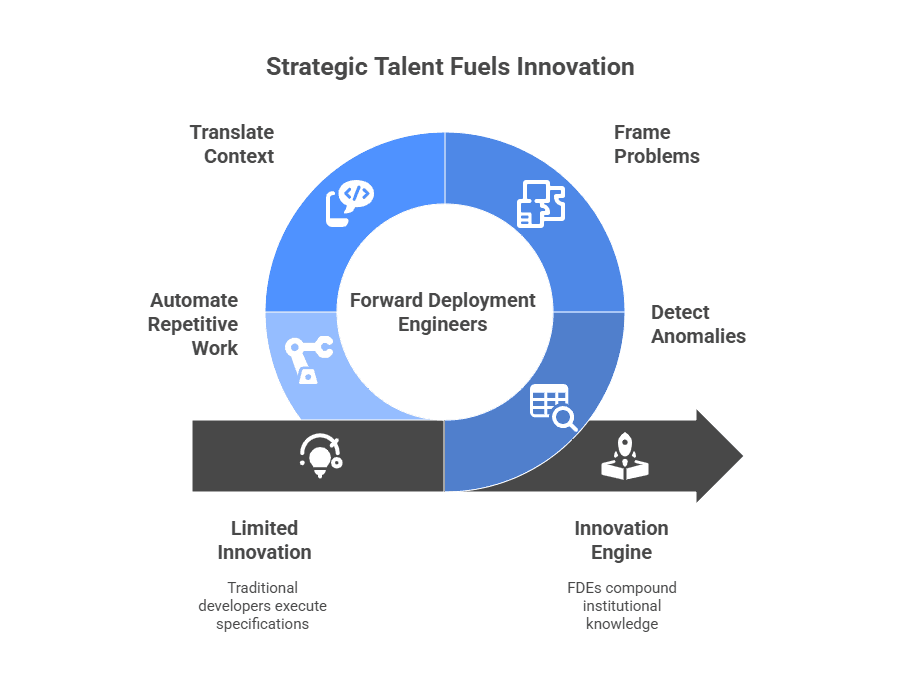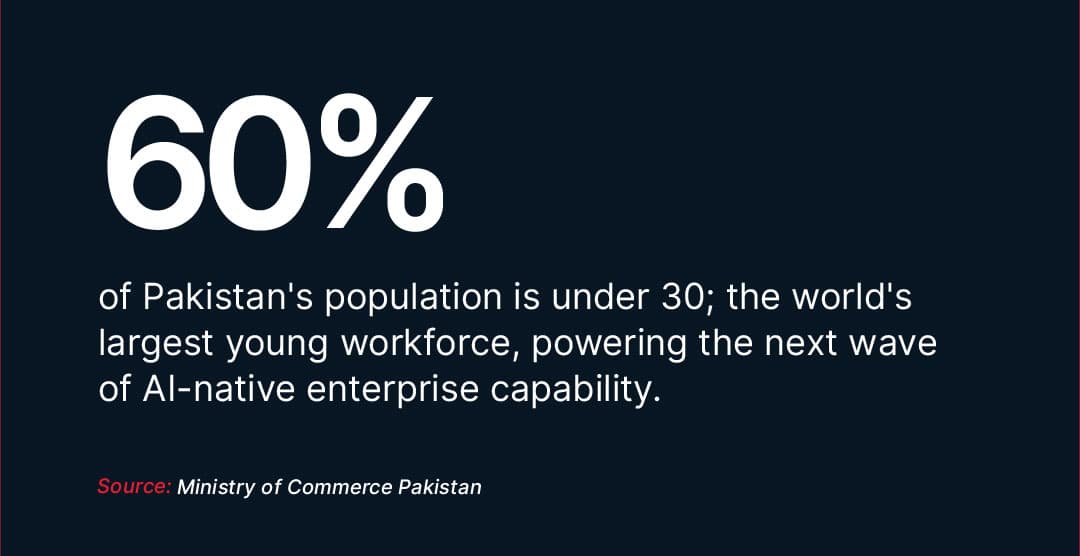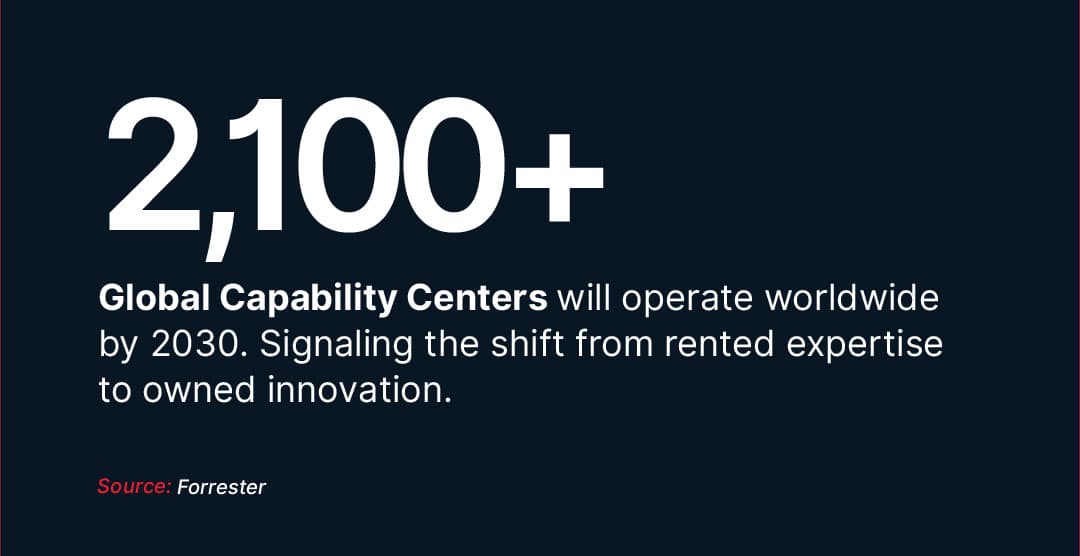The Sovereign Enterprise: Reclaiming Innovation in the Post-Consulting Era
27 October, 2025
Key Takeaways
- Innovation sovereignty marks a structural shift in enterprise strategy. From renting intelligence to owning it, from outsourcing capability to engineering it in-house.
- Global Capability Centers (GCCs) are no longer peripheral delivery units. They are the new architecture of resilience, turning distributed intelligence into enterprise advantage.
- The new equilibrium emerges when organizations design learning, not control. Where talent, data, and AI coalesce into continuously compounding innovation.
- The architecture of resilience is built on capability, not convenience. Those who control their talent pipelines control their innovation destiny.
- The consulting century optimized efficiency; the sovereignty era architects continuity. Where learning becomes infrastructure, and transformation becomes a perpetual state.
For decades, a familiar ritual defined enterprise problem-solving. A challenge arose; consultants arrived, frameworks were presented, and insights departed with them.
The expertise never stayed. The cycle persisted; not by accident, but by design. This was the architecture of dependency.
The earlier installments of this series traced why the consulting model, built for sustaining innovation, falters in an age demanding disruption, and how Global Capability Centers (GCCs) emerged as the structural antidote and blueprint for self-sustaining innovation.
This final piece looks beyond the break in that cycle. It explores what the new equilibrium looks like when enterprises reclaim the means of innovation.
When internal capability building becomes the architecture of enterprise transformation and the foundation of innovation sovereignty.
What Innovation Sovereignty Actually Looks Like
Innovation sovereignty is more about velocity than control. In the age of intelligence, the measure of resilience is how fast an enterprise can sense disruption, translate it into learning, and adapt before the market even registers the shift (KPMG, 2024).
Modern global capability centers have evolved beyond cost centers to become the enterprise nervous system. They decentralize capability into regions rich in talent, aligning local expertise with global systems through shared data, governance, and AI-native collaboration.
Learn More: Resilient by Design - The Strategic Advantage of GCCs in Enterprise Growth
This is organizational design for innovation in practice: distributed intelligence synchronized by shared purpose.
But distributed intelligence demands a new archetype of talent. It requires problem framers and architects of change who turn knowledge into operational intelligence.
Learn more: Elite Multiplication: How AI Is Reshaping Organizational Capability and Design
How Does Strategic Talent Turn Global Capability Centers into Innovation Engines?
Modern Global Capability Centers are the enterprise’s innovation engine, with Forward Deployment Engineers (FDEs) as its ignition, translating intelligence into impact.
" Traditional developers execute predefined specifications. Forward Deployment Engineers operate differently. They detect anomalies, frame problems, and translate business context into executable systems. "
Guided by the enterprise AI strategy, they automate repetitive work so they can focus on problem discovery.
This bridges the gap between consultants who recommend and engineers who implement. Unlike external advisors whose insights dissipate when contracts end, the FDEs compound institutional knowledge with every operational cycle.

This is 'capability building strategy' in action: creating competitive moats that cannot be rented or replicated.
The challenge, of course, is finding them. And that is where geography matters.
The Demographic Dividend: Where the Next Frontier of Innovation Capability Is Forged
Building innovation capability demands more than skilled labor. It requires ecosystems of AI-native talent capable of shaping new paradigms, not retrofitting old ones.
Pakistan stands at this inflection point. With a 240M+ population, 60% under 30,

it represents the world's largest young workforce, producing over 25,000 AI-native graduates annually (Ministry of Commerce Pakistan, 2024). This demographic dividend creates unprecedented talent availability at precisely the moment enterprises need it most.
Just as Pakistan bypassed landline infrastructure to become mobile-first by being the fastest adopters of 3G/4G technology, its workforce is bypassing legacy paradigms to build AI-native capabilities directly.
The economics reinforce the strategic logic: 33% lower costs than India, 70% lower than onshore US operations, without sacrificing English proficiency or technical sophistication.
While India leads in scale and the Philippines excels in customer experience, Pakistan's demographic dividend positions it as the next-generation hub for enterprises seeking forward deployment talent.
" Intelligence ownership has become the new data sovereignty enterprise imperative. But intelligence does not build itself. Enterprises that fail to develop in-house AI capabilities risk becoming overly dependent on proprietary systems, limiting both transparency and innovation (Gartner 2024). "
The systems are only as sovereign as the talent that architects them. Controlling talent pipelines is controlling innovation destiny.
Learn More: Strategic Ownership: Rewriting the AI Buy–Build Debate
Architecting Enterprise Intelligence for the AI Era
The Global Capability Center operating model now evolves through interconnected frameworks that transform delivery hubs into continuous learning systems.
CodeNinja’s Distributed Team Structure (DTS) framework provides the architectural foundation, replicating enterprise governance and compliance while preserving local agility. It creates a holacracy of intelligence, where decisions happen closer to context and knowledge compounds across regions.
Learn more: CodeNinja's Diamond Team Structure (DTS) Framework: A Scalable Approach to Capability Centers
Impact engineering shifts focus from activity to advantage, embedding capability frameworks that tie innovation velocity, competitive differentiation, and measurable ROI directly to enterprise outcomes.
Finally, Hyper infrastructure enables AI-native workflows that turn GCCs into innovation engines. It integrates human-AI collaboration, ensures data sovereignty, and operationalizes frontier R&D.
This is capability building engineered, not theorized.
Where consultants deliver advice, CodeNinja delivers architectural sovereignty; building systems, teams, and infrastructures that continuously learn and evolve.
The cycle of rented intelligence ends here; what emerges is the architecture of owned innovation.
When the Exception Becomes the Rule
As more enterprises master internal capability building, a systemic shift unfolds. What began as isolated experiments now defines a new enterprise growth strategy.
The Global Capability Center ecosystem generates over $64.6 billion in value, challenging the very economics of traditional consulting. Moreover, GCC establishments are projected to surge to more than 2,100 by 2030, marking a structural shift from rented expertise to owned innovation (Forrester 2025).

Those achieving innovation sovereignty now outpace peers bound by external dependency by:
- Adapting faster
- Protecting intellectual property
- Compounding organizational capability through proprietary talent pipelines (BCG, 2024)
" The new status quo is emerging: enterprises with their own internal innovation engines no longer compete, they redefine the game. "
This transformation finally answers the question that has long challenged successful enterprises since Christensen first articulated it: how do you disrupt yourself before someone else does? (Christensen, 1997)
The answer was never in the technology strategy or choices enterprises made. It was in organizational design; who owns the capacity to innovate, who architects the enterprise growth strategy, and who holds sovereignty over the systems that learn, adapt, and evolve.
The Dilemma, Resolved
Christensen's theory explained why incumbents fail: they optimize for sustaining innovations that serve existing customers while missing disruptive innovations that create new markets. The same logic applies to how enterprises build innovation capability itself.
Consulting models represent sustaining innovation: refining existing advisory relationships, optimizing billable hours, serving established client needs.
Global capability centers represent disruptive innovation: competing on different terms, through ownership rather than rental, compounding knowledge rather than transient expertise, building capabilities that transform the economics of innovation itself.
The dilemma is resolved by shifting the locus of control. The consulting century taught enterprises to outsource their hardest problems. The sovereignty era teaches them to own their capacity to solve those problems continuously.
Those who control their capability-building destiny will disrupt those who outsource it.
True advantage lies not in what you rent, but in what you build. CodeNinja helps enterprises design the systems, teams, and intelligence they can truly own.
Bibliography
- Christensen, Clayton M. The Innovator's Dilemma: When New Technologies Cause Great Firms to Fail. Boston: Harvard Business School Press, 1997. https://www.hbs.edu/faculty/Pages/item.aspx
- Boston Consulting Group (BCG). 2024. "Global Capability Centers: Cautiously Advancing Gen AI." BCG Publications. https://media-publications.bcg.com/Global-Capability-Centers-Cautiously-Advancing-Gen-AI.pdf
- Gartner. 2024. "Build vs. Buy Strategy: Top Principles for Enterprise Applications." Gartner Insights. https://www.gartner.com/en/doc/build-vs-buy-strategy-top-principles-for-enterprise-applications
- McKinsey & Company. 2024. "The Future of Global Centers." McKinsey Insights. https://www.mckinsey.com/capabilities/operations/our-insights/the-future-of-global-centers
- Ministry of Commerce, Government of Pakistan. 2024. "Business Process Outsourcing Sector Strategy Pakistan." https://moitt.gov.pk/SiteImage/Misc/files/Pakistan%27s%20IT%20Industry%20Report-Printer.pdf
- KPMG. 2024. "GCCs in India: Building Resilience for Sustainable Growth." KPMG. May. https://assets.kpmg.com/content/dam/kpmgsites/in/pdf/2024/05/gccs-in-india-building-resilience-for-sustainable-growth.pdf
FAQs
Q1. What defines true innovation sovereignty in a global enterprise?
Innovation sovereignty is achieved when enterprises internalize the intelligence loop; sensing, learning, and adapting without external intermediation.
It’s not about independence from partners, but about owning the architecture, data, and talent pipelines that sustain continuous transformation.
Q2. How do Global Capability Centers redefine enterprise innovation strategy?
Global Capability Centers (GCCs) decentralize innovation while maintaining unified governance. They convert global talent ecosystems into intelligence hubs, aligning regional capabilities with enterprise-wide objectives; turning operational centers into engines of strategic transformation and knowledge compounding.
Q3. Why is organizational design more critical than technology choices for innovation?
Technology creates capacity, but organizational design determines how that capacity is applied. Enterprises that engineer flatter, AI-native operating models transform from reactive hierarchies into adaptive systems. Where learning, becomes the true source of resilience and innovation.
Learn more: Hierarchy to Holacracy - The Modern Enterprise Design
Q4. What role does intelligence ownership play in enterprise resilience?
Owning intelligence is the modern form of sovereignty. When enterprises develop in-house AI capabilities, they preserve data sovereignty and reduce dependency on black-box vendors.
They control how insights translate into decisions, ensuring that competitive differentiation remains proprietary, not rented.
Q5 : What role does infrastructure play in achieving innovation sovereignty?
Sovereignty isn’t just about owning capability. It’s about owning the systems that enable it. GCC infrastructure provides the foundation for distributed, AI-powered collaboration and scaling.
Read more: Rethinking Infrastructure: How GCCs Are Evolving as Innovation Layers for Global Scaling
